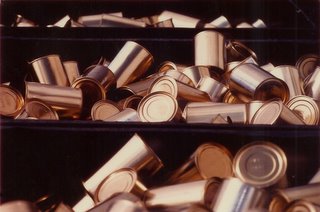A Tale of Two Cans

This story involves the famous movie maker, Francis Ford Coppola. Seems he has a vinyard in the Napa Valley in California and decided to sell champagne. The wine growers in California had already got together and beat out the French who were saying that good wine only comes from France. So it's no surprise that Coppola took on the last sales pitch the French had, that champagne had to come from the Champagne region of France. (Regional pink salmon branders beware.)
To make a long story short, he put up 5,000 cases of champagne IN CANS. They sold out so fast he just finished putting up 50,000 cases. Vintage? It gets consumed so fast that asking about the vintage comes after the can is empty, so the story goes.
But he did what I have blogged about before, he started with the demographic, Generation Y, etc. and designed a product form for a product he already had. He had wines, so he blended them and made it bubbly. Then he thought that these young people should be taking it to all the places where brewskis have reigned; football games, picnics, etc. Hence the can. And a straw. A pink can and a colored straw. Definitely a girlie drink. And for $4.99 a split.
We've been saying "take the salmon out of the can" for a long time. There is just too much of Alaska's salmon going into a tall steel can to make for good returns for fishermen. With some large processors backing off from taking the salmon out of the can, SOMEONE has to be the Francis Ford Coppola of the fishing industry. It has to be done in a big way, so it'll probably be one of the new regional associations.
Story number two is about the first ever flash freezing:
Clarence Birdseye sold rats to a Columbia University scientist to help himself get through Amherst College. He discovered that fish and game that was frozen quickly tasted better than if it was frozen slowly. In 1923 he started freezing rabbit and fish fillets with dry ice. He soon started the General Seafoods Company to market his foods better.
A few years later he sold the company to General Foods, which changed the name of his brand to "Birds Eye." Clarence thought that was fine, since his family had taken on the name Birds Eye after an ancestor saved an English queen by shooting an attacking hawk in the eye.
I'll bet you didn't know that the high quality of Alaska's frozen seafood (frozen at minus 20 degrees F. or lower) is because a guy was putting himself through college selling frozen rats. I sure didn't. Little matter how the breakthrough came about, Clarence Birdseye got rich doing something about a better idea. Sounds like there was a family heritage of taking the bull by the horns too.


0 Comments:
Post a Comment
<< Home